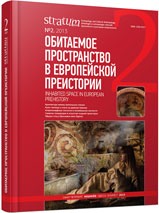Опыт анализа распределения глиняной антропоморфной пластики в погребениях нео-энеолитического могильника Дуранкулак (Северо-Восточная Болгария)
The Distribution of Clay Figurines in the Neolithic and Copper Age Necropolis of Durankulak (North-Eastern Bulgaria): A Case Study
Author(s): Stanislav V. ŢernaSubject(s): History, Archaeology, Cultural history, Ancient World
Published by: Издательский дом Stratum, Университет «Высшая антропологическая школа»
Keywords: Hamangia; Varna; necropolis; Durankulak; ritual; anthropomorphic figurines; social status; cenotaph; gender inversion;
Summary/Abstract: The usage of clay figurines in the funerary ritual of South-East European Neolithic and Copper Age cultures is an interesting and relatively little-studied phenomenon. This article represents an analysis of different aspects, bound with the presence of clay figurines in the large Neolithic and Copper Age necropolis of Durankulak (North-Eastern Bulgaria). It has been determined, that figurines served as an exponent of the status of an individual, and their diversified use accompanied the substantial social transformations on the transition from Neolithic to Copper Age. A particular attention is drawn on the special cases of use of figurines, such as cenotaphs or placing a figurine in a male burial. Also, the article discusses different aspects of deposition of figurines in Hamangia, Varna and other cultures in South-East Europe from Neolithic to the Early Bronze Age.
Journal: Stratum plus. Археология и культурная антропология
- Issue Year: 2013
- Issue No: 2
- Page Range: 167-198
- Page Count: 32
- Language: Russian
- Content File-PDF

